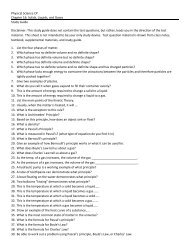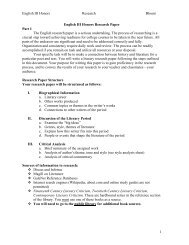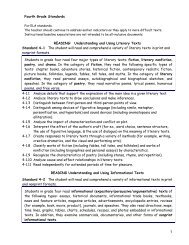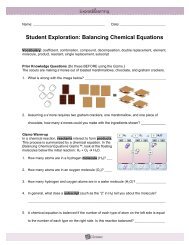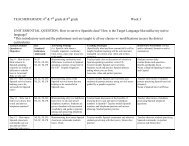Investigating Rotational & Reflectional Symmetry of Quadrilaterals
Investigating Rotational & Reflectional Symmetry of Quadrilaterals
Investigating Rotational & Reflectional Symmetry of Quadrilaterals
Create successful ePaper yourself
Turn your PDF publications into a flip-book with our unique Google optimized e-Paper software.
1<strong>Investigating</strong> <strong>Rotational</strong> & <strong>Reflectional</strong><strong>Symmetry</strong> <strong>of</strong> <strong>Quadrilaterals</strong>Task 1 – <strong>Investigating</strong> <strong>Rotational</strong> <strong>Symmetry</strong>• Open the Sketchpad sketch entitled “QuadsNCTM.”• In the Definitions file <strong>of</strong> the sketch, check out the related terms and theirdescriptions.• In the <strong>Rotational</strong> <strong>Symmetry</strong> file <strong>of</strong> the sketch, follow the directions <strong>of</strong> thesketch. Record your findings in the table below.• In the Kite file <strong>of</strong> the sketch, follow the directions <strong>of</strong> the sketch. Record yourfindings in the table below.• In the Trapezoid file <strong>of</strong> the sketch, follow the directions <strong>of</strong> the sketch. Recordyour findings in the table below.Task 2 - <strong>Investigating</strong> <strong>Reflectional</strong> <strong>Symmetry</strong>• In the Midsegments & <strong>Symmetry</strong> file <strong>of</strong> the sketch, follow the directions <strong>of</strong> thesketch. Record your findings in the table below.• In the Diagonals & <strong>Symmetry</strong> file <strong>of</strong> the sketch, follow the directions <strong>of</strong> thesketch. Record your findings in the table belowType <strong>of</strong><strong>Symmetry</strong>Parallelogram Rhombus Rectangle Square Trapezoid IsoscelesTrapezoidKite<strong>Rotational</strong><strong>Symmetry</strong>?Angle(s) <strong>of</strong><strong>Symmetry</strong><strong>Reflectional</strong><strong>Symmetry</strong>?Mid-midline(s) –MD or IT?Diagonal(s)– QA orUD?• In the Quads file <strong>of</strong> the sketch, follow the directions <strong>of</strong> the sketch. Recordyour findings in the table.
2Quadrilateral Parallelogram Rhombus Rectangle Square Trapezoid IsoscelesTrapezoidKiteOpposite sides≅ ?Oppositeangles ≅ ?Opposite sidesparallel?At least onepair <strong>of</strong> parallelsides?At least oneright angle?Consecutiveanglessupplementary?Diagonals ≅ ?Diagonals ⊥ ?Diagonalsbisect eachother?Diagonalsbisect anglesQ, U, A & D?Type <strong>of</strong>VarignonQuadrilateral*CyclicQuadrilateral?Diacenter?Medcenter?
Task 3 – Varignon <strong>Quadrilaterals</strong>• In the Varignon quad file <strong>of</strong> the sketch, follow the directions <strong>of</strong> the sketch.Record your findings in the table.Task 4 – Making <strong>Quadrilaterals</strong> from Triangle Pairs• Open the Triangles & Quads Sketchpad sketch.• In the Generic Triangle Maker file <strong>of</strong> the sketch, follow the directions <strong>of</strong> thesketch. Record your findings in the table below; what type <strong>of</strong> quadrilateral isformed when ∆ABC is reflected? When ∆ABC is rotated? Complete the gridwith: isosceles triangle, parallelogram, rhombus, rectangle, square, kiteor concave kite.• In the Obtuse Triangle Maker file <strong>of</strong> the sketch, follow the directions <strong>of</strong> thesketch. Record your findings in the table below.• In the Right Triangle Maker file <strong>of</strong> the sketch, follow the directions <strong>of</strong> thesketch. Record your findings in the table below.• In the Isosceles Maker file <strong>of</strong> the sketch, follow the directions <strong>of</strong> the sketch.Record your findings in the table below.• In the Equilateral Triangle Maker file <strong>of</strong> the sketch, follow the directions <strong>of</strong> thesketch. Record your findings in the table below.GenericTriangleMakerObtuseTriangleMakerRight TriangleMakerIsoscelesTriangleMakerEquilateralTriangleMakerReflection inACReflection inABReflection inBC180° Rotationabout midpoint<strong>of</strong> AC180° Rotationaboutmidpoint <strong>of</strong>AB180° Rotationaboutmidpoint <strong>of</strong>BC
4Theorem: The vertices <strong>of</strong> two congruent triangles that share a common sideform a parallelogram, a kite or a cyclic quadrilateral.Task 5 – A Closer look at the <strong>Quadrilaterals</strong>• In the Parallelogram file <strong>of</strong> the sketch, follow the directions <strong>of</strong> the sketch.Complete the following.o A quadrilateral is a parallelogram if any <strong>of</strong> the following exist:••••o In a parallelogram:•••••• In the Isosceles Trapezoid file <strong>of</strong> the sketch, follow the directions <strong>of</strong> thesketch. Complete the following.o Isosceles trapezoid theorems:•••••••• In the Rectangle file <strong>of</strong> the sketch, follow the directions <strong>of</strong> the sketch.Complete the following.o A rectangle is a special case <strong>of</strong> a(n)________________.o A quadrilateral is a rectangle if any <strong>of</strong> the following conditions exist:•••o A rectangle is a _______________ .o In a rectangle:••••• In the Rhombus file <strong>of</strong> the sketch, follow the directions <strong>of</strong> the sketch.Complete the following.o Rhombus theorems:•••
5••• In the Definitions file <strong>of</strong> the sketch, activate the diagonals button. Completethe following.o A quadrilateral is a kite if and only if• It satisfies its definition – a kite is a quadrilateral in which atleast one diagonal defines a line <strong>of</strong> symmetry oralternatively, a kite is a quadrilateral with two distinct pairs <strong>of</strong>consecutive, congruent sides.• One <strong>of</strong> its diagonals is the __________________________ .• One <strong>of</strong> its diagonals is the ____________ <strong>of</strong> the angles at itsendpoints.o The bisectors <strong>of</strong> the angles <strong>of</strong> a kite are concurrent.Assessment – Quadrilateral Riddles – Who Am I?1. No matter how I change, I always have two pairs <strong>of</strong> sides with thesame length and at least one line <strong>of</strong> symmetry. Sometimes I have onlyone line <strong>of</strong> symmetry. Which quadrilateral am I?2. No matter how I change, I always have at least one pair <strong>of</strong> parallelsides. Which quadrilateral am I?3. Whenever I have a right angle, I’m a rectangle. Sometimes not all <strong>of</strong>my sides have the same length and I have no right angles. Whichquadrilateral am I?4. I’m always a parallelogram. I’m always a kite. Sometimes I’m not allright. Which quadrilateral am I?5. I always have at least two lines <strong>of</strong> symmetry. Sometimes not all <strong>of</strong> mysides have the same length. Which quadrilateral am I?6. I can have two right angles or four right angles, but never just one.Which quadrilateral am I?7. I always have the measures <strong>of</strong> any two adjacent anglessupplementary. Sometimes not all <strong>of</strong> my sides have the same length.I don’t always have right angles. Which quadrilateral am I?8. Sometimes I have four different side lengths. Sometimes no pair <strong>of</strong> myangles is supplementary. Which quadrilateral am I?
6Task 6 – Quadrilateral Constructions Using <strong>Symmetry</strong>• How can a parallelogram be constructed using its symmetryand transformations? Describe a method.• How can a kite be constructed using its symmetry andtransformations? Describe a method.• How can an isosceles trapezoid be constructed using itssymmetry and transformations? Describe a method.• How can a rectangle be constructed using its symmetry andtransformations? Describe a method.• How can a rhombus be constructed using its symmetry andtransformations? Describe a method.• How can a square be constructed using its symmetry andtransformations? Describe a method.* It might be helpful to discuss the notion <strong>of</strong> angle-side duality. For example,the rectangle and rhombus are duals – the rectangle’s angles are all equaland the rhombus’s sides are all equal. Also, duality <strong>of</strong> the kite and theisosceles trapezoid is illustrated in the table:Isosceles TrapezoidKite• Two pairs <strong>of</strong> equal adjacent angles • Two pairs <strong>of</strong> equal adjacent sides• One pair <strong>of</strong> equal opposite sides • One pair <strong>of</strong> equal opposite angles• Circumscribed circle (cyclic) • Inscribed circle (circum quad)• An axis <strong>of</strong> symmetry through one pair<strong>of</strong> opposite sides• An axis <strong>of</strong> symmetry through one pair<strong>of</strong> opposite angles
7ReferencesBattista Michael T. 1998. Shape Makers – Developing Geometric Reasoningwith the Geometer’s Sketchpad®. Emeryville: Key Curriculum Press.De Villiers, Michael D. 1999. Rethinking Pro<strong>of</strong> with the Geometer’sSketchpad®. Emeryville: Key Curriculum Press.Keyton, Michael. 1996. 92 Geometric Explorations on the TI-92. Dallas: St.Mark’s School.Wells, David. 1991. The Penguin Dictionary <strong>of</strong> Curious and InterestingGeometry. England: Penguin Books.




